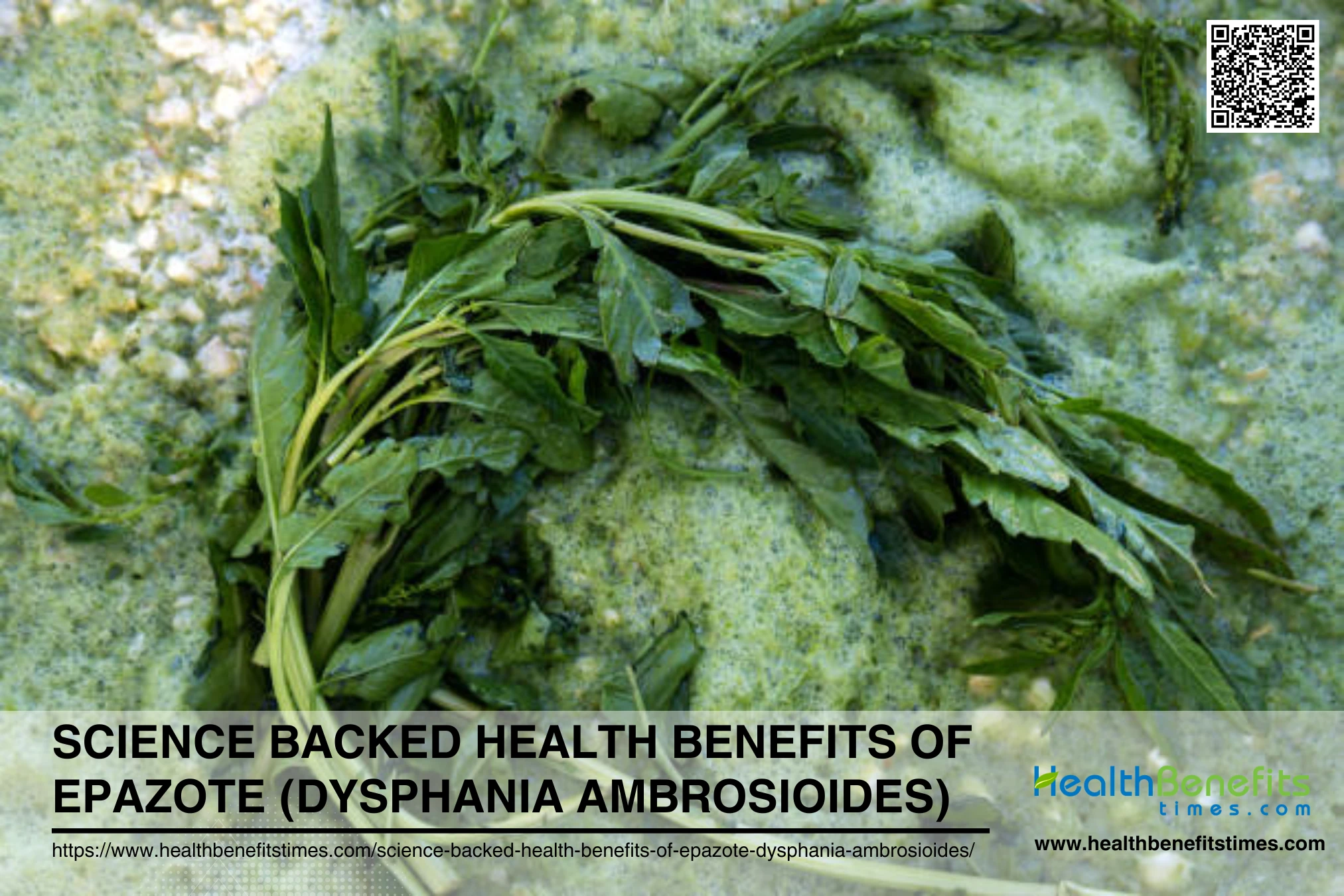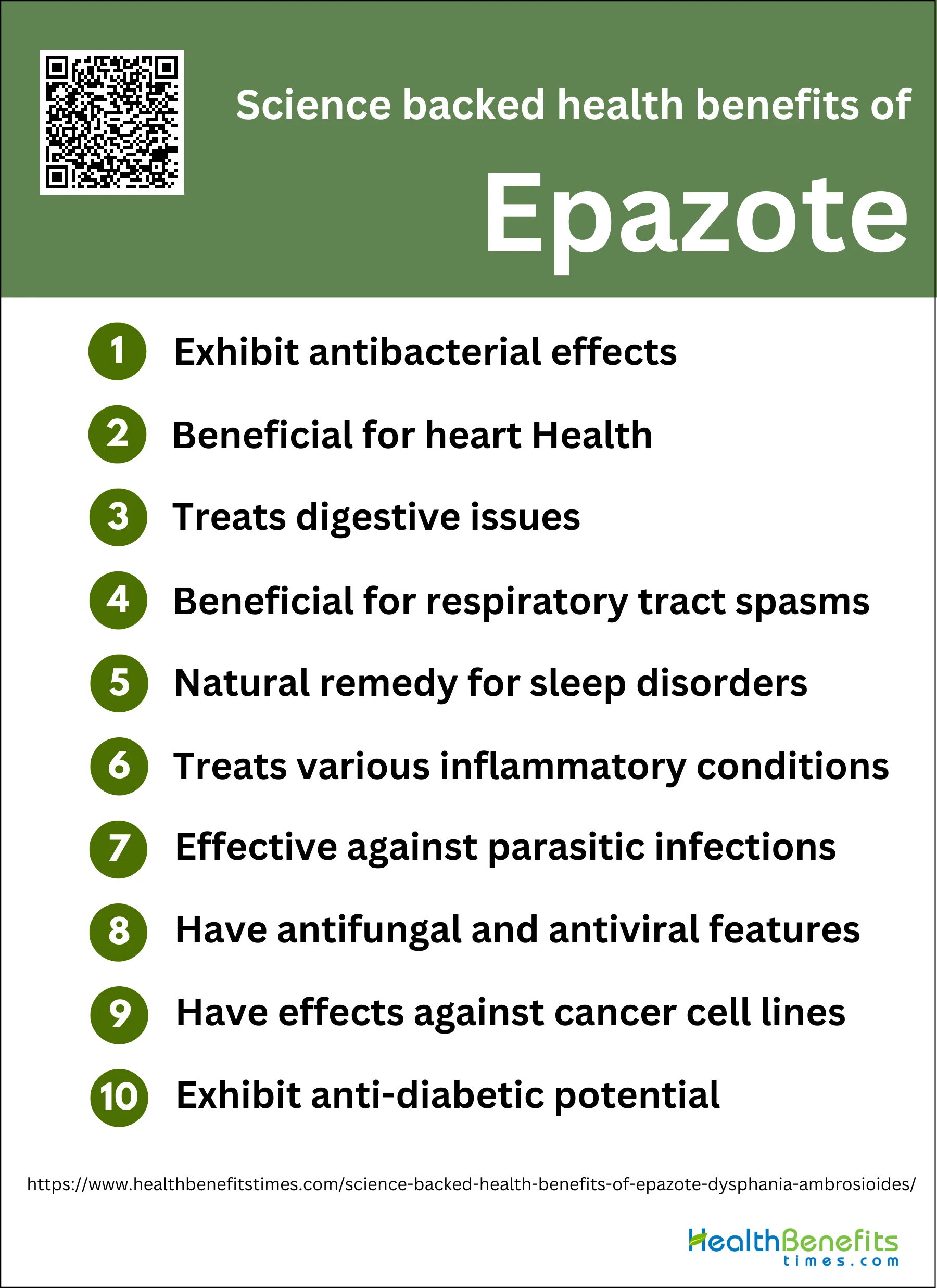- Epazote is a perennial herb, medicinal uses, pest control, rich in nutrients.
- Epazote is a mexican herb, antibacterial, digestive aid, heart health, culinary uses.
- Epazote relaxes respiratory muscles, alleviates spasms, and eases breathing.
- Epazote is eEffective against parasitic infections, intestinal worms, and schistosomiasis.
- Epazote enhances Mexican dishes’ flavor; use sparingly, add towards end.
- Epazote is a culinary herb, potential toxicity, use sparingly, consult healthcare professional.
 Epazote (Dysphania ambrosioides), also known as Mexican tea or wormseed, is a herb with a long history of use in traditional Mexican and Central American cuisine and medicine. While its pungent aroma and flavor make it a popular culinary ingredient, particularly in bean dishes, epazote has also garnered attention for its potential health benefits. This article explores the science-backed health benefits of epazote, examining how this ancient herb’s properties may contribute to modern wellness practices. From its digestive aid capabilities to its antimicrobial and anti-inflammatory effects, we’ll delve into the research supporting epazote’s role in promoting health and managing various conditions.
Epazote (Dysphania ambrosioides), also known as Mexican tea or wormseed, is a herb with a long history of use in traditional Mexican and Central American cuisine and medicine. While its pungent aroma and flavor make it a popular culinary ingredient, particularly in bean dishes, epazote has also garnered attention for its potential health benefits. This article explores the science-backed health benefits of epazote, examining how this ancient herb’s properties may contribute to modern wellness practices. From its digestive aid capabilities to its antimicrobial and anti-inflammatory effects, we’ll delve into the research supporting epazote’s role in promoting health and managing various conditions.
What is Epazote ?
Epazote is a perennial herb native to Central and South America, widely recognized for its medicinal and culinary uses. It has been traditionally used to control various pests and diseases due to its bioactive compounds. For instance, studies have demonstrated that the ethanolic extract of epazote can effectively inhibit the mycelial development of phytopathogenic fungi such as Fusarium oxysporum and Fusarium solani, suggesting its potential as a natural fungicide. Additionally, epazote powder has been shown to control weevil damage in maize, with higher concentrations significantly reducing weight loss, damaged grains, and insect survival. However, epazote itself can be susceptible to diseases, as evidenced by the first report of downy mildew caused by Peronospora chenopodii-ambrosioidis in North Carolina, which highlights the need for further research on its cultivation and disease management.
Nutritional Profile of Epazote:
Epazote boasts a rich nutritional profile that contributes to its culinary and medicinal uses. This aromatic plant is packed with essential nutrients, including vitamins, minerals, and unique compounds that offer potential health benefits. Despite its strong flavor, epazote is low in calories, with approximately 32 calories per 100 grams of fresh leaves. It also provides a good amount of dietary fiber, about 3.8 grams per 100 grams, which supports digestive health. The diverse array of nutrients in epazote makes it a valuable addition to a balanced diet, offering both flavor and nutritional benefits.
Overview of the key nutrients found in Epazote:
Epazote is a nutritional powerhouse, containing a wide range of essential nutrients that contribute to overall health and well-being. The herb is particularly rich in vitamins A, C, and B-complex vitamins, especially folate. It also provides a significant amount of minerals, including calcium, iron, and magnesium. Epazote contains dietary fiber, which aids in digestion and promotes gut health. Additionally, the herb is known for its unique phytochemicals, such as ascaridole and various flavonoids, which contribute to its medicinal properties. This combination of vitamins, minerals, and beneficial compounds makes epazote a valuable herb for both culinary and therapeutic purposes.
Vitamins (A, B-complex, C):
Epazote is a rich source of several essential vitamins that play crucial roles in maintaining overall health. The herb contains a significant amount of vitamin A, providing approximately 57 IU per 100 grams, which is important for vision, immune function, and skin health. Epazote is also an excellent source of vitamin C, offering about 3.6 mg per 100 grams, which acts as a powerful antioxidant and supports immune function. Furthermore, the herb is particularly rich in B-complex vitamins, especially folate (vitamin B9), containing around 215 μg per 100 grams. Folate is essential for DNA synthesis and cell division, making it particularly important during pregnancy and for overall cellular health.
Minerals (Calcium, Iron, Magnesium):
Epazote is a notable source of several essential minerals that are vital for various bodily functions. The herb is particularly rich in calcium, providing approximately 275 mg per 100 grams, which is crucial for bone health, muscle function, and nerve signaling. Epazote also contains a significant amount of iron, about 1.88 mg per 100 grams, which is essential for oxygen transport in the blood and energy production. Additionally, the herb is a good source of magnesium, offering around 121 mg per 100 grams. Magnesium plays a key role in numerous biochemical reactions in the body, including energy production, protein synthesis, and muscle and nerve function. These minerals, along with others like potassium (633 mg per 100g), manganese (3.1 mg per 100g), and zinc (1.1 mg per 100g), contribute to the overall nutritional value of epazote.
Other beneficial compounds (Ascaridole, Flavonoids):
Epazote contains several unique compounds that contribute to its medicinal properties and potential health benefits. One of the most notable is ascaridole, a monoterpene peroxide that gives epazote its distinctive aroma and flavor. Ascaridole has been traditionally used for its anthelmintic (anti-worm) properties, which may explain epazote’s historical use in treating intestinal parasites. The herb also contains other monoterpene compounds such as limonene and terpinene, which have potential antioxidant and anti-inflammatory effects. Additionally, epazote is rich in flavonoids, including quercetin and kaempferol, which are known for their antioxidant properties. These flavonoids, along with other phenolic compounds and beta-carotenes found in epazote, may contribute to the herb’s potential anti-inflammatory, antimicrobial, and antioxidant effects, although more research is needed to fully understand their impact on human health.
Science backed health benefits of Epazote
Epazote is gaining attention in the scientific community for its potential health benefits. This pungent, leafy green plant, often used to flavor beans and other dishes, has been the subject of numerous studies exploring its medicinal properties. From its digestive benefits to its antimicrobial and anti-inflammatory effects, epazote is proving to be more than just a culinary herb. In this article, we’ll explore the science-backed health benefits of epazote, shedding light on why this ancient herb might deserve a place in modern health and wellness routines.
1. Exhibit antibacterial effects
Epazote has demonstrated significant antibacterial effects in various scientific studies. Methanolic extracts from epazote fruits exhibit antibacterial activity against several pathogenic bacteria, including Enterococcus faecalis, Salmonella typhimurium, and Escherichia coli. The essential oil of epazote has also been found to be active against E. coli, Staphylococcus aureus, Pseudomonas aeruginosa, and Bacillus subtilis, with minimum inhibitory concentrations (MIC) ranging from 10 to 20 μL/mL. These antibacterial properties are attributed to the presence of various compounds in epazote, particularly ascaridole and other monoterpenes. Additionally, studies have shown that epazote extracts can inhibit the growth of Helicobacter pylori, a bacterium associated with gastric ulcers and cancer. The plant’s antibacterial activity extends to its potential use in food preservation, as demonstrated by its application in raw ground pork to prevent bacterial growth.
What research Says?
- The essential oils of Dysphania ambrosioides have many plant compounds, mainly monoterpenes like cis-piperitone oxide, p-cymene, isoascaridole, and α-terpinene. These compounds might help the plant fight bacteria. Also, flavonoids and other organic compounds in the plant could add to its bioactivity.
- Study shows that the essential oils from Dysphania ambrosioides fight many bacteria. For example, these oils have stopped bacteria like Escherichia coli, Staphylococcus aureus, and Enterococcus faecalis from growing. Another study found that the oil was not as strong against Streptococcus sobrinus and Enterococcus faecalis, but it was very good at killing parasites that cause schistosomiasis.
- The antibacterial power of Dysphania ambrosioides comes from its many plant chemicals. The main parts of the essential oils, like ascaridole, play a big role in its effectiveness. Scientists have used computer methods to study these plant compounds. They looked at things like ADMET analysis and molecular docking. This helps show how these compounds work and their potential as drugs.
- Study compares how we get extracts from the plant Dysphania ambrosioides and what we use to dissolve them. They affect how well the extracts can fight bacteria. For instance, extracts with water and alcohol worked well to relax muscles and stop spasms. This helps their ability to kill bacteria. Also, a mix of methanol and water from the leaves showed strong germ-killing power. This shows that how you extract things is key to making the most active extracts.
2. Beneficial for heart Health

While epazote has been traditionally used for various medicinal purposes, its effects on cardiovascular health are complex and require careful consideration. Epazote may have cardiac-stimulant properties, which could potentially benefit cardiovascular health by increasing heart rate. However, it’s crucial to note that these effects can be a double-edged sword. The herb contains compounds that may affect heart rhythm, and for this reason, it is generally advised that individuals with cardiovascular disease or impaired kidney function should avoid using epazote medicinally. The plant’s potential to influence heart function means it should be used with caution, especially in concentrated forms or as an essential oil. While epazote contains antioxidants like flavonoids and beta-carotenes that may have protective effects against oxidative stress, which is beneficial for overall health including cardiovascular health, more research is needed to fully understand its impact on the cardiovascular system.
What research Says?
- The leaves of Dysphania ambrosioides have lots of good compounds like rutin, myricetin, and quercetin. Experts found these through a special test called HPLC-DAD. These compounds are great at stopping damage from oxidation. This is important for keeping the heart and blood vessels healthy.
- Dysphania ambrosioides may help with heart health because it can lower blood pressure. This is good for controlling high blood pressure, a big risk for heart problems. The plant’s effect might come from special compounds that relax the muscles in blood vessels.
- Researchers looked at how the essential oil from Dysphania ambrosioides (EODa) and its main part, α-terpinene, relax muscles in rat tracheas. They found that EODa and α-terpinene help the trachea’s muscles relax by blocking L-type calcium channels. This blockage lowers the amount of Ca2+ going into the cells. This process is important for relaxing blood vessel muscles, which helps lower blood pressure caused by the plant.
3. Treats digestive issues
Epazote is renowned for its ability to treat various digestive issues, a benefit that has been recognized in traditional medicine for centuries. The herb is particularly effective in alleviating symptoms such as bloating, cramping, and flatulence, which are common discomforts associated with high-fiber diets, especially those rich in beans and legumes. Epazote contains compounds like ascaridole, which have carminative properties that help reduce gas and promote smoother digestion. Additionally, its infusion can stimulate the production of gastric juices, aiding in the breakdown of food and easing indigestion. The antibacterial and antiseptic properties of epazote further contribute to its digestive benefits by preventing harmful bacteria and viruses from disrupting the digestive system.
What Research Says?
- The study of D. ambrosioides shows it has many active parts, like flavonoids including rutin, myricetin, and quercetin. These parts are known to stop oxidation, which helps the plant’s healing power. We found these compounds using different ways to get them out, such as with water-alcohol mixes, chloroform, and ethyl acetate.
- Studies show that the plant D. ambrosioides can help relax muscles and stop spasms. The plant’s extract has a strong muscle-relaxing effect with an IC50 value of 0.39 ± 0.01 mg/mL. It also stops spasms with an IC50 value of 0.51 ± 0.05 mg/mL. These effects come from blocking certain calcium channels in muscles, which helps them relax. The essential oil from D. ambrosioides and a key part of it, α-terpinene, also help relax muscles in the airways. This supports its use for stopping muscle spasms.
- ambrosioides is not just good for digestion. It also has anti-inflammatory, stomach-protecting, and germ-fighting effects. These benefits make it even better for treating stomach problems and related health issues.
4. Beneficial for respiratory tract spasms

Essential oil extracted from this plant exhibits myorelaxant properties, particularly on smooth muscle tissues. The plant contains compounds like α-terpinene, which may contribute to this effect. Additionally, traditional uses of epazote include treating respiratory conditions such as asthma, bronchitis, and catarrh. Its anti-inflammatory and expectorant properties, combined with its ability to relax lung tissues, make it a potentially valuable herb for addressing respiratory tract spasms and promoting easier breathing.
What Research Says?
- Study has shown that the plant Dysphania ambrosioides can relax muscles and stop spasms. This is especially true for its essential oil and other extracts. When tested on rat tracheal muscle, the essential oil (EODa) and a key part called α-terpinene helped relax the muscle. They did tests in special baths that measure muscle contractions. EODa and α-terpinene were able to reduce contractions caused by potassium, acetylcholine, and serotonin. This suggests they might help with spasms in the breathing passages.
- Another study found that a liquid made from Dysphania ambrosioides flowers helped relax muscles and stop spasms. This liquid had a strong muscle-relaxing effect at a concentration of 0.39 mg/mL. It also worked well to prevent spasms at a concentration of 0.51 mg/mL. The plant’s high flavonoid levels, which are thought to be helpful compounds, explain these effects. This supports the traditional use of the plant for treating spasms.
- The healing power of the plant Dysphania ambrosioides comes from its many plant-based chemicals. It has different active substances like ascaridole, p-cymene, α-terpinene, terpinolene, carvacrol, and trans-isoascaridole. These have been shown to help in many ways, such as fighting oxidation, reducing swelling, and killing microbes. These substances make Dysphania ambrosioides useful for treating spasms in the breathing passages.
5. Natural remedy for sleep disorders
Dysphania ambrosioides has shown promise as a natural remedy for sleep disorders due to its sedative properties. The essential oil extracted from epazote leaves contains significant amounts of ascaridole and p-cymene, compounds that have been scientifically proven to promote sleep. Studies involving the administration of epazote essential oil to mice have demonstrated a marked decrease in locomotor activity and a significant extension of pentobarbital-induced sleep duration, effects that are mediated through the GABAergic system, which is crucial for regulating sleep and relaxation.
What Research Says?
- Study shows that giving DAEO through breathing greatly lowers movement in mice given caffeine. This suggests it may have calming effects. Two chemicals, ascaridole and p-cymene, cut down movement by over 50%. They also made sleep last longer by 42% and 77% when given with a sleeping drug. These calming effects come from the GABA system. This is shown by how flumazenil, which works against GABA receptors, stops these effects.
6. Treats various inflammatory conditions
The herb contains several bioactive compounds, including flavonoids and terpenoids, which contribute to its anti-inflammatory properties. Extracts from D. ambrosioides can significantly inhibit the production of pro-inflammatory cytokines and reduce the activation of macrophages, which are key players in the inflammatory response. Additionally, studies have shown that the herb’s hydroalcoholic and ethanolic extracts possess potent anti-nociceptive and anti-inflammatory effects, making it effective in reducing pain and inflammation in conditions such as arthritis and other inflammatory diseases.
What Research Says?
- ambrosioides has many active substances like terpenoids, flavonoids, coumarins, and fatty acids. People think these help with its healing powers, such as reducing swelling.
- The essential oil from D. ambrosioides and its main part, α-terpinene, can relax muscles in the airways. This suggests it could help treat breathing problems that involve swelling and spasms.
7. Effective against parasitic infections

Dysphania ambrosioides has been scientifically validated as an effective remedy against parasitic infections. The herb’s potent anthelmintic properties are primarily attributed to its high content of ascaridole, a compound known for its ability to paralyze and eliminate intestinal worms such as hookworms and pinworms. Epazote’s essential oil exhibits significant activity against various parasites, including Entamoeba histolytica, the causative agent of amebiasis, and Schistosoma mansoni, responsible for schistosomiasis. Epazote extracts can reduce parasite burden, decrease the number of eggs in feces and liver, and mitigate granulomatous inflammation associated with parasitic infections.
What Research Says?
- The essential oil from D. ambrosioides and its main part, α-terpinene, can relax muscles in the airways. This suggests it could help treat breathing problems that involve swelling and spasms.
- ambrosioides can kill amoebas well. Research on its impact on Entamoeba histolytica showed that its essential oil needs only 0.7 mg/mL to work against the amoebas. Giving this oil to sick hamsters made them better. Ascaridole is the key part that fights the infection. This backs up the old way of using D. ambrosioides to treat amoebiasis.
- The essential oil from D. ambrosioides was tested for its ability to kill Biomphalaria tenagophila snails. These snails carry S. mansoni, which causes schistosomiasis. The oil killed all the snails at 10 parts per million (ppm) in 24 hours. The LC50 and LC90 values were 2.40 ppm and 8.75 ppm, respectively. This means D. ambrosioides oil might help control the spread of schistosomiasis by killing these snails.
8. Have antifungal and antiviral features
The essential oil extracted from this plant has shown significant antifungal activity against several species of Candida, including C. albicans, with minimum inhibitory concentrations (MIC) ranging from 0.25 to 2.00 mg/mL. Additionally, the essential oil has exhibited antiviral effects against the Coxsackie B4 virus (CV-B4), with an IC50 value of 21.75 μg/mL. The plant’s antifungal and antiviral activities are attributed to its rich composition of bioactive compounds, particularly ascaridole, which is a major component of its essential oil. These properties make D. ambrosioides a promising candidate for the development of natural antifungal and antiviral agents, potentially offering alternatives to conventional treatments in both medical and agricultural applications.
What Research Says?
- The essential oil from the plant Dysphania ambrosioides has strong antifungal powers. It works well against several fungus types. For example, oil from this plant in Morocco stopped fungi like Fusarium oxysporum and others by 78% to 90% when used at 500 µg/mL. Also, this oil worked against Botrytis cinerea. It cut down the growth of the fungus by about 60% and spore starting by 51% at 1000 ppm.
- Another study showed that the essential oil from D. ambrosioides has strong powers against the fungus Candida albicans, a harmful yeast. The oil works well because it has key parts like ascaridole, p-cymene, and α-terpinene. It also fights off fungi that rot wood, like Trametes versicolor and Phanerochaete chrysosporium. This means it could help protect wood materials.
- People have looked at how the essential oils from a plant called Dysphania ambrosioides work together to fight germs. When you mix these oils with oils from another plant, Seriphidium herba-alba, they work even better against a germ called Streptococcus agalactiae. This shows that the oil from D. ambrosioides can be mixed with other plant oils to get a stronger germ-fighting effect.
9. Have effects against cancer cell lines
Dysphania ambrosioides has shown anticancer effects against various cancer cell lines in preclinical studies. The essential oil extracted from D. ambrosioides has shown potent cytotoxic activity against human breast cancer MCF-7 cells, with an IC50 value of 10.50 μg/mL after 48 hours of treatment. In another study, the essential oil inhibited the growth of MCF-7 cells, exhibiting a strong antitumor effect in vitro. Additionally, D. ambrosioides seed extract (CSE) has been found to suppress the migration and invasion of SMMC-7721 hepatocellular carcinoma cells, with IC50 values of 0.587 g/L, 0.360 g/L, and 0.361 g/L at 24, 36, and 48 hours, respectively. The anticancer activity of D. ambrosioides is attributed to its rich composition of bioactive compounds, particularly ascaridole, which was identified as the compound with the highest content (25.82%) in the seed extract.
What research Says?
- Dysphania ambrosioides has shown strong anticancer effects in studies. One important study looked at different medicinal plants used in the Peruvian Amazon. It checked their antioxidant and anticancer powers. Out of eight plants tested, Dysphania ambrosioides stood out. It worked against a wide range of cancer cells. The plant was effective against Caco-2, HT-29, and Hep-G2 cancer cell lines. The IC50 values were 129.2, 69.9, and 130.6 µg/mL. The study thinks alkaloids and phenolic compounds in the plant help with its anticancer and antioxidant actions. This supports its use in traditional medicine.
10. Exhibit anti-diabetic potential

The plants aqueous and methanolic leaf extracts have shown hypoglycemic effects in both normoglycemic and glucose-loaded rat models, suggesting its ability to lower blood glucose levels. In acute conditions, a single oral administration of these extracts was found to reduce fasting blood glucose in rats. The plant’s anti-diabetic properties are attributed to its rich composition of bioactive compounds, including flavonoids, alkaloids, saponins, tannins, and terpenoids. D. ambrosioides extracts can inhibit α-glucosidase activity, with the dichloromethane-methanol fraction showing the highest effectiveness (IC50 value of 20.4 ± 0.72 µM). Additionally, the plant has demonstrated antioxidant properties, which may contribute to its potential in managing diabetes-related oxidative stress.
What Research Says?
- Dysphania ambrosioides has many bioactive compounds that give it healing properties. Important chemicals found in the plant are rutin, myricetin, quercetin, α-terpinene, β-cymene, p-cymene, piperitone, carvyl acetate, and limonene. These compounds help because they have antioxidant, anti-inflammatory, and enzyme-blocking actions. These are important for controlling diabetes.
- The plant Dysphania ambrosioides is known for its antioxidant power. Studies show that a methanol extract from the leaves can fight free radicals well. It has an IC50 value of about 130.7 μg/mL. Also, an extract made with water and ethanol shows strong antioxidant activity. This is important for fighting the oxidative stress linked to diabetes.
How to Incorporate Epazote into Your Diet
Incorporating epazote into your diet can add a unique and aromatic flavor to a variety of dishes. This herb is particularly popular in Mexican and Central American cuisines, where it is used to enhance the taste of beans, soups, stews, and moles. To start, you can add a small amount of fresh or dried epazote to your recipes, such as frijoles de la olla (pot beans) or quesadillas. It’s best to add epazote towards the end of the cooking process to preserve its distinctive flavor. Always use it in moderation to avoid overpowering your dish and to ensure safety.
Culinary Uses of Epazote
Epazote is a versatile herb used in many traditional Mexican dishes. It is often added to beans, such as black beans and pinto beans, to reduce gas and enhance flavor. The herb is also a key ingredient in soups, stews, and moles, providing a deep, earthy taste that complements other ingredients. In addition to its use in cooked dishes, epazote can be used fresh in salads or as a garnish. Its strong, pungent flavor makes it a unique addition to many recipes, offering a taste that is both medicinal and aromatic.
Common Dishes and Traditional Recipes
Epazote is featured in a variety of traditional recipes, including frijoles de la olla, tortilla soup, and mole verde. It is also used in dishes like Oaxacan-style mushroom quesadillas and papadzules, a rolled corn tortilla dish from Yucatán. Another popular use is in pulique, a Guatemalan stew with Mayan origins. These dishes highlight the herb’s ability to add depth and complexity to flavors, making it an indispensable ingredient in many regional cuisines. Recipes often call for fresh epazote, but dried can be used if fresh is not available.
Tips for Using Fresh and Dried Epazote in Cooking
When using fresh epazote, it is best to add the leaves and tender stems towards the end of the cooking process to preserve their flavor. Fresh epazote can be stored in a glass of water in the refrigerator, similar to fresh herbs like cilantro. If using dried epazote, remember that its flavor is less intense than fresh, so you may need to use a bit more. A general guideline is to use one teaspoon of dried epazote for every fresh stem called for in a recipe. Always taste and adjust as needed to avoid overpowering your dish.
Flavor Profile and Best Practices
Epazote has a strong, pungent flavor that is often described as medicinal, with notes of anise, mint, and camphor. Its unique taste can be an acquired one, but it adds a distinctive layer of flavor to many dishes. To get the best results, use epazote sparingly and add it towards the end of cooking. This helps to retain its aromatic qualities without overwhelming the other flavors in the dish. Whether using fresh or dried epazote, always start with a small amount and adjust to taste, ensuring that the herb enhances rather than dominates your culinary creations.
Safety and Precautions
Epazote, also known as Dysphania ambrosioides, is a herb commonly used in culinary applications, particularly in Latin American cuisine. While it is safe to use in small amounts as a flavoring agent, caution is necessary when using it in larger quantities or in concentrated forms like teas or extracts. The herb contains compounds such as ascaridole, which can be toxic if ingested in significant amounts. Therefore, it is crucial to consult with a healthcare professional before using epazote for medicinal purposes and to avoid self-medication. Pregnant and breastfeeding women should particularly avoid using epazote due to its potential to cause uterine contractions and other adverse effects.
Potential Side Effects and Toxicity
Epazote contains ascaridole, a chemical known for its toxic properties. Potential side effects of consuming epazote in large quantities include dizziness, skin irritation, vomiting, deafness, paralysis, liver damage, and even death. The toxicity is particularly pronounced in the essential oil form of the herb, which has been linked to severe health issues and fatalities. Symptoms of poisoning can occur even with relatively low doses, making it imperative to use epazote with caution and under professional guidance.
Importance of Proper Dosage and Preparation
The proper dosage and preparation of epazote are critical to ensuring its safe use. In culinary applications, a small amount of the herb is typically sufficient to impart flavor without posing health risks. For instance, one tablespoon of dried epazote per cup of dry beans is a common guideline. When using fresh epazote, 2-3 sprigs per cup of dry beans are recommended. It is essential to add the herb towards the end of the cooking process to preserve its flavor and minimize the risk of toxicity. Overuse or improper preparation can lead to adverse effects, highlighting the importance of adhering to recommended dosages.
Recommendations for Safe Use
To safely incorporate epazote into your diet, use it sparingly as a culinary herb. It is best suited for flavoring beans, soups, stews, and other traditional dishes. Avoid using concentrated forms such as teas or extracts unless under the supervision of a healthcare provider. Pregnant and breastfeeding women should avoid using epazote altogether. Always consult with a healthcare professional before using epazote for medicinal purposes to ensure it is appropriate for your specific health needs and conditions.
Who Should Avoid Using Epazote
Certain individuals should avoid using epazote due to its potential health risks. Pregnant and breastfeeding women are advised against using the herb because it can cause uterine contractions and increase the risk of premature birth. Additionally, individuals with liver or kidney conditions should avoid epazote due to its toxic effects on these organs. Children are also particularly vulnerable to the toxic effects of epazote and should not consume it. As a general rule, anyone considering using epazote for medicinal purposes should first consult with a healthcare professional to determine if it is safe for their specific health circumstances
Conclusion
In conclusion, epazote is a versatile herb with a rich nutritional profile and numerous potential health benefits. Its unique combination of vitamins, minerals, and bioactive compounds contributes to its antibacterial, anti-inflammatory, antifungal, and antiviral properties. While epazote shows promise in treating various conditions, from digestive issues to parasitic infections, and even demonstrates potential anticancer effects, it’s crucial to use it cautiously due to its potent nature. The herb’s traditional uses in cuisine and medicine are increasingly supported by scientific research, highlighting its value in both culinary and therapeutic applications. However, more studies are needed to fully understand its mechanisms of action and potential side effects. As with any herbal remedy, it’s advisable to consult with a healthcare professional before using epazote for medicinal purposes, especially for pregnant women, children, and individuals with pre-existing health conditions.
ADDITIONAL RESOURCES
Here is a list of US organizations involved in research on vegetables, along with short descriptions and URLs:
1. USDA Economic Research Service (ERS)
The USDA ERS provides detailed analysis and data on the supply, demand, price, and trade of fresh and processed vegetables, including specialty crops. They publish reports such as the “Vegetables and Pulses Outlook,” which offers insights into the vegetable market and production trends.
2. Bayer Vegetables Research and Development Site
Located in Woodland, California, this site focuses on developing healthy and sustainable vegetable varieties. Bayer collaborates with growers and partners across the value chain to enhance agricultural practices and improve food security.
This international nonprofit institute is dedicated to vegetable research and development. The center works to improve the production and consumption of vegetables, particularly in developing countries, to enhance nutrition and livelihoods.
4. Feed the Future Innovation Lab for Horticulture at UC Davis
This organization focuses on improving the production and consumption of horticultural crops, including vegetables, in developing countries. Their research addresses nutrition, income, and food security challenges, particularly through promoting indigenous vegetables.
Bayer’s vegetable seed division supports sustainable agriculture through innovative breeding programs and solutions. They aim to improve vegetable quality and yield while addressing issues like disease resistance and environmental sustainability.
Recommendations for books on Epazote
Here are some recommendations for books on “research on Epazote” with links:
This research article discusses the ethnobotanical, morphological, phytochemical, and molecular characteristics of epazote, providing evidence for its domestication.
This book details the use of epazote as a source of natural antioxidants in meat products, highlighting its potential to improve the stability and quality of food.
3. “Chemical Composition and Antifungal Activity of the Essential Oil of Epazote“
This book covers the chemical composition and antifungal properties of epazote essential oil, emphasizing its potential applications in agriculture and medicine.
FAQS
- What is Epazote?
Epazote is a traditional herb native to Central America and Mexico, known for its strong, pungent aroma and flavor. It is used in cooking, particularly in Mexican cuisine, and has various medicinal properties.
- What are the nutritional components of Epazote?
Epazote is rich in vitamins such as Vitamin C, Vitamin A, and several B vitamins. It also contains minerals like calcium, magnesium, iron, potassium, and zinc. Additionally, it has dietary fiber, omega-3 and omega-6 fatty acids, and no cholesterol.
- How does Epazote benefit digestive health?
Epazote contains dietary fiber that aids in digestion by promoting bowel movements and reducing constipation, bloating, and gas. Its carminative properties help in reducing flatulence, making it a popular addition to bean dishes.
- Can Epazote boost the immune system?
Yes, Epazote is rich in antioxidants, particularly Vitamin C and Vitamin A, which help in boosting the immune system by fighting free radicals and enhancing the production of white blood cells.
- What are the anti-parasitic properties of Epazote?
Epazote contains ascaridole, a compound toxic to intestinal worms like hookworms and roundworms. It has been traditionally used to treat parasitic infections, although it should be used under medical supervision due to potential toxicity.
- Is Epazote beneficial for bone health?
Epazote is high in minerals such as calcium, phosphorus, and manganese, which are essential for maintaining bone density and preventing osteoporosis.
- How does Epazote affect metabolic activity?
Epazote contains significant levels of B-complex vitamins, particularly folic acid, which are crucial for metabolic processes. These vitamins help in energy production and overall metabolic efficiency.
- Can Epazote help in weight management?
With only 32 calories per 100 grams and high fiber content, Epazote can help in weight management by promoting a feeling of fullness and aiding in digestion.
- Does Epazote have anti-inflammatory properties?
Yes, Epazote has been shown to have anti-inflammatory properties due to its flavonoid content, which can help reduce inflammation and may be beneficial in conditions like arthritis.
- Are there any precautions when using Epazote?
Epazote should be used in moderation due to its potent compounds like ascaridole, which can be toxic in large amounts. It is not recommended for pregnant or breastfeeding women as it can cause uterine contractions and other adverse effects


